Free Vocational Training Centres by SRM Foundation inaugurated at Kuragallu
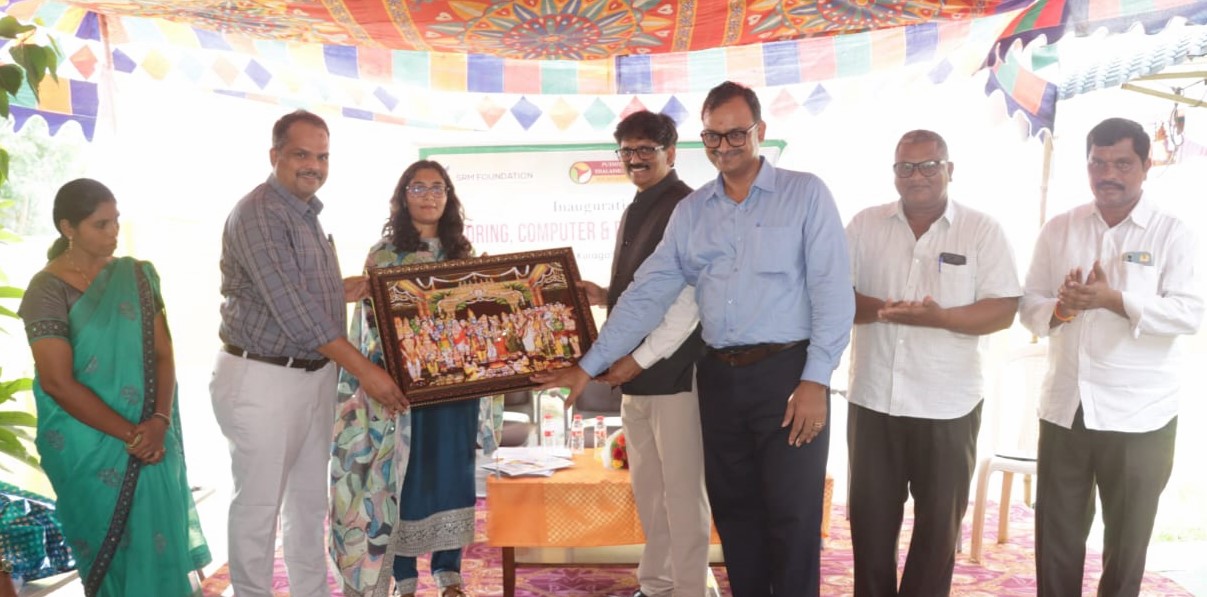 In a significant step towards empowering rural women through education and skill development, multiple free training centres were established in Kuragallu village on Wednesday, under the auspices of the SRM Foundation and Tenali Sub-Collector, Sanjana Sinha inaugurated these centres.
In a significant step towards empowering rural women through education and skill development, multiple free training centres were established in Kuragallu village on Wednesday, under the auspices of the SRM Foundation and Tenali Sub-Collector, Sanjana Sinha inaugurated these centres.
The newly launched centres offer free training in computer skills, tailoring, and academic support through tuition classes. These centres aim to promote self-employment and digital literacy among women and students in the region.
Sub-Collector, Sanjana Sinha, and SRM University- AP, Amaravati’s Pro-Vice Chancellor, Prof. Satish Kumar, formally opened the facilities and interacted with women beneficiaries at the site. Speaking at the inauguration, Sub-Collector Sinha lauded the SRM Foundation’s initiative, stating, “SRM-AP, being the largest educational institution in Amaravati, is igniting the flame of knowledge for thousands, and I am pleased to see such esteemed organisations stepping forward to serve rural communities free of cost.”
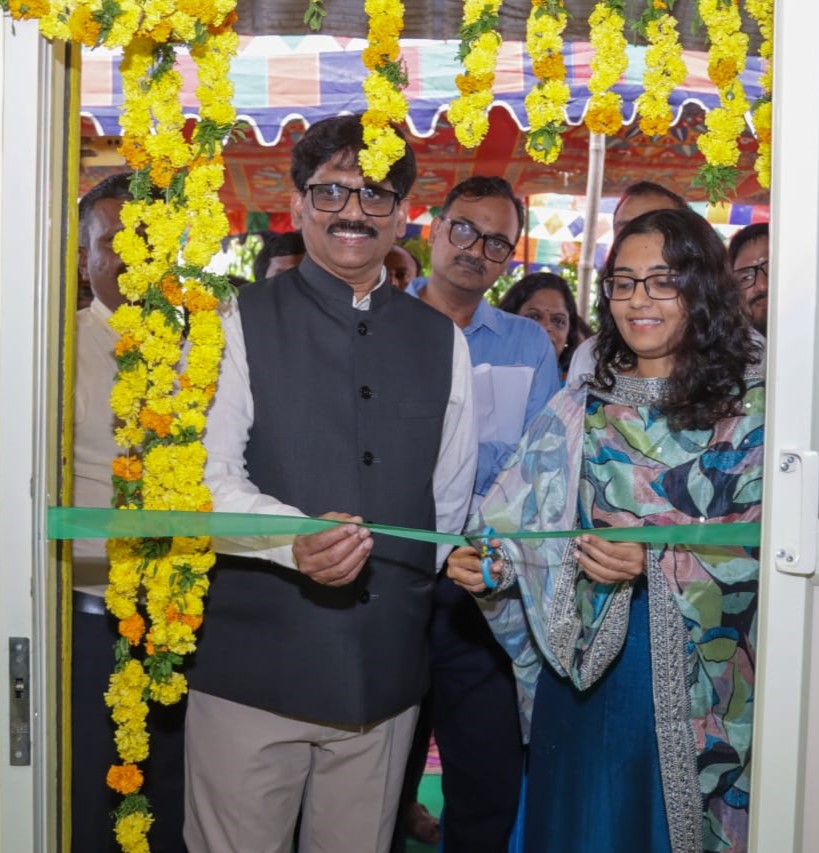
She added that basic computer literacy is essential in today’s digital world, and this training will be a game-changer for many. She urged residents to take full advantage of the expert-led training programs in their village.
SRM-AP’s, Pro-Vice Chancellor, Prof. Satish Kumar, highlighted the Foundation’s mission to foster economic independence among rural women. “Our tailoring and computer training programs are designed to equip women with skills that lead to self-employment and sustainable livelihoods. Education remains the pathway to greater success,” he said.
SRM Foundation Secretary D V Venkatagiri emphasised that these free services are already operational in Chennai, Amaravati, and Delhi, with three centres launched in the Amaravati region and plans for further expansion.
In a gesture of appreciation, villagers felicitated Pro-Vice Chancellor Prof. Satish Kumar and Foundation Director Dr Venkatagiri for their contributions. Additionally, Sub-Collector Sinha honoured SRM Tuition Centre educators Prathipati Sushma, Punyavani Konduru Bharathi Prameela, and Dhana Kumari, presenting them with shawls in recognition of their service. As part of the launch event, books, school bags, and stationery were distributed to students attending the tuition centres.
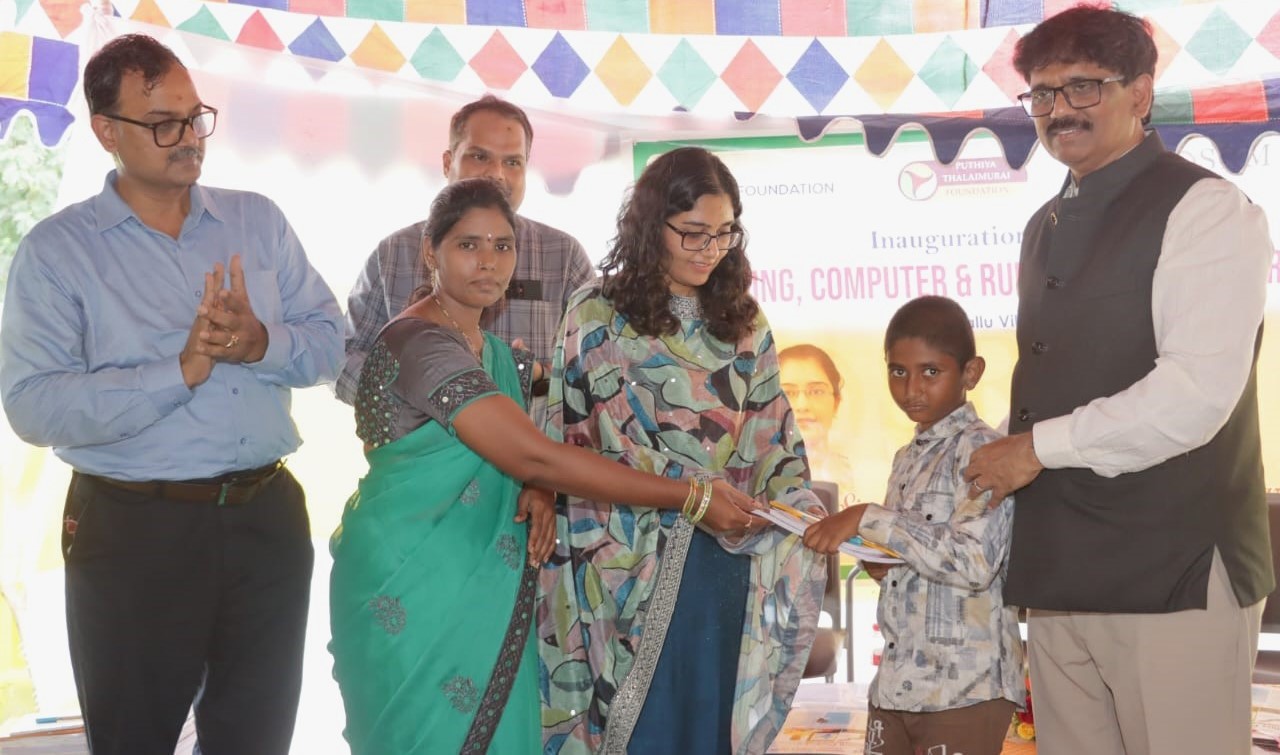
- Published in News
Review of The Bloomsbury Handbook to the Digital Humanities (DH)
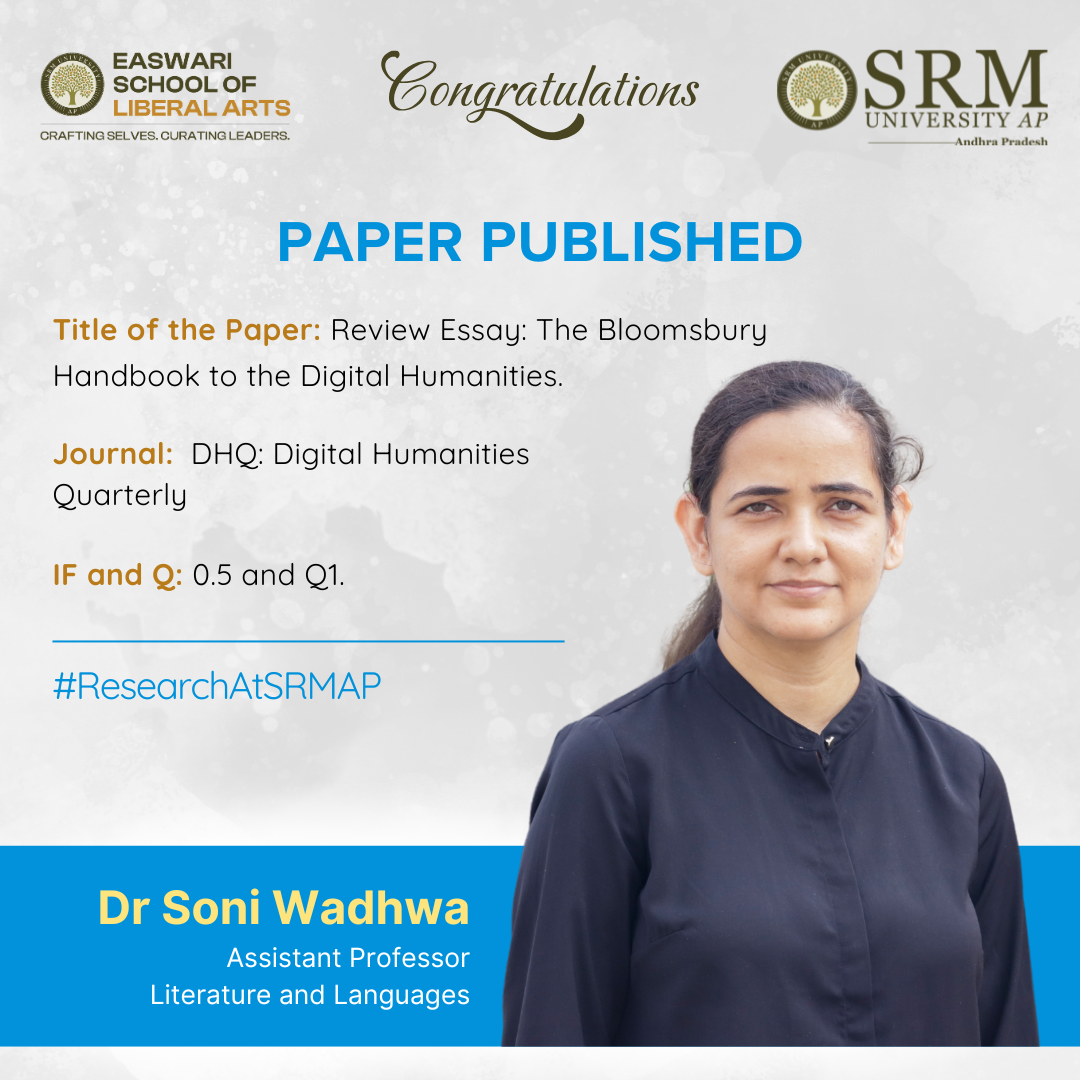 A handbook is a complex and demanding genre, it must offer a comprehensive overview of a field, articulating its foundational principles, charting ongoing debates, and identifying potential future directions. Such volumes are often judged as much by what they exclude as by what they include. Within this context Dr Soni Wadhwa, Assistant Professor in the Department of Literature and Languages, approached “The Bloomsbury Handbook to the Digital Humanities” in her review essay published in the Q1 journal “DHQ: Digital Humanities Quarterly”.
A handbook is a complex and demanding genre, it must offer a comprehensive overview of a field, articulating its foundational principles, charting ongoing debates, and identifying potential future directions. Such volumes are often judged as much by what they exclude as by what they include. Within this context Dr Soni Wadhwa, Assistant Professor in the Department of Literature and Languages, approached “The Bloomsbury Handbook to the Digital Humanities” in her review essay published in the Q1 journal “DHQ: Digital Humanities Quarterly”.
Abstract
The Bloomsbury Handbook, edited by James O’Sullivan is framed as a forward-looking resource aimed at fostering further developments in the field of digital humanities (DH). In his introduction, O’Sullivan notes that the volume is designed to serve three categories of readers: DH experts, the DH-curious, and skeptics. The collection is divided into five thematic sections: “Perspectives & Polemics,” “Methods, Tools, & Techniques,” “Public Digital Humanities,” “Institutional Contexts,” and “DH Futures.” Each section features chapters that provide overviews of key subfields while engaging with specific methodological and theoretical issues.
In her review, Dr Wadhwa refrains from summarising all 43 chapters. Instead, she evaluates what the handbook offers to the different categories of readers it aims to serve. She highlights the volume’s self-critical tone and its ability to generate meaningful dialogue about the contributions and challenges of digital humanities in analysing culture and text.
Dr Wadhwa also addresses the misconceptions and hesitations that often surround digital humanities, particularly among scholars from humanities and social sciences who may feel excluded due to a lack of technical expertise. Her review seeks to demystify the field by showcasing exemplary work from leading scholars, thereby offering guidance to researchers interested in exploring DH.
Practical Implementations and Future Research plans:
She hopes that her essay will encourage aspiring researchers to delve deeper into the various subdomains of digital humanities and engage with the field with greater confidence. Dr Wadhwa emphasises the need for more accessible resources and institutional support for digital humanities, asserting its growing relevance within academia.
Looking ahead, she intends to build further on her work in the area of digital archiving which is a vital subdomain within digital humanities. She plans to write more extensively about the projects she has undertaken, contributing to the evolving discourse and practice of the field.
- Published in Departmental News, English Current Happenings, English news, News, Research News
Kunja Rajitha, SRM-AP’s Trailblazer, Clinches Gold at the 26th Asian Athletics Championship
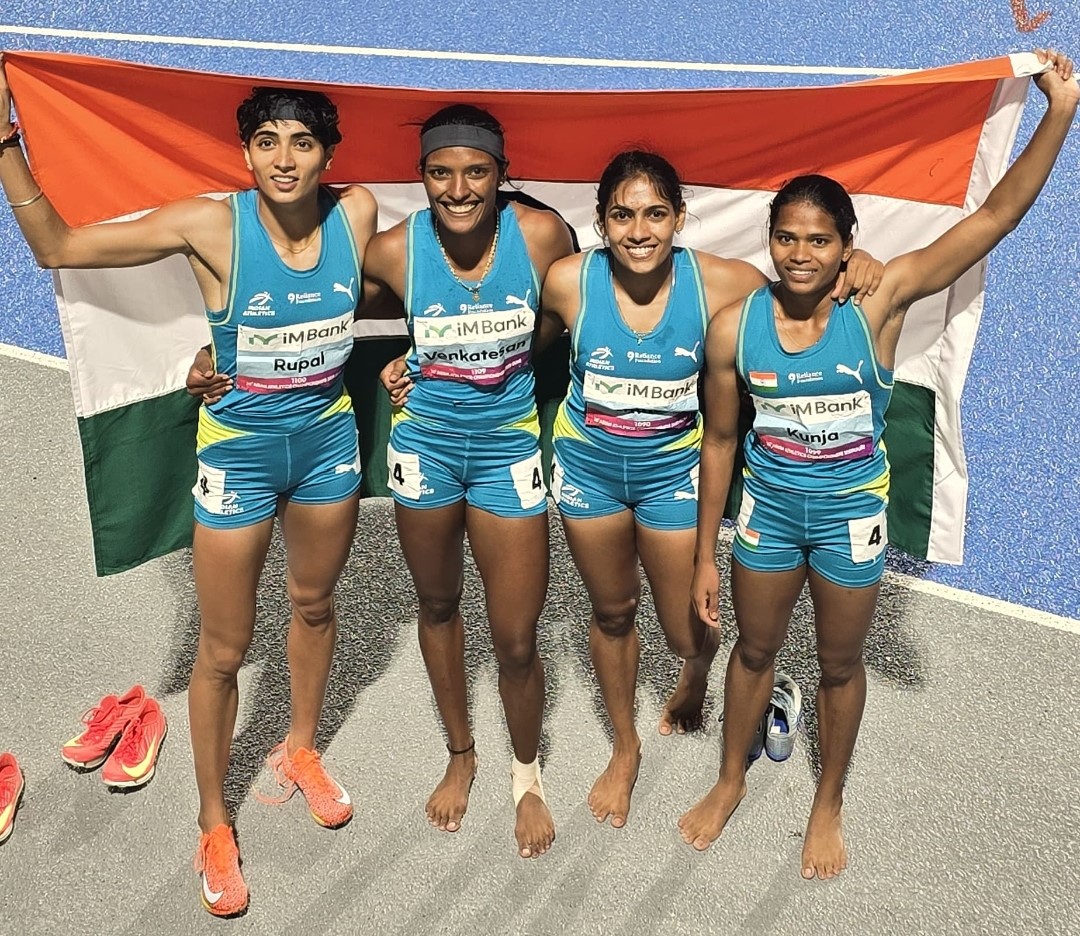 Ms Kunja Rajitha, a first-year B.Com. student at Paari School of Business, SRM University-AP, Amaravati, brought immense pride to the nation and the institution by clinching a Gold Medal in the Women’s 4×400m Relay at the 26th Asian Athletics Championship held at Gumi, South Korea, on Thursday.
Ms Kunja Rajitha, a first-year B.Com. student at Paari School of Business, SRM University-AP, Amaravati, brought immense pride to the nation and the institution by clinching a Gold Medal in the Women’s 4×400m Relay at the 26th Asian Athletics Championship held at Gumi, South Korea, on Thursday.
Rajitha was part of the formidable relay team, which included Jisna Mathew, Rupal Chaudhary, and Subha Venkatesan. The team delivered a season-best time of 3:34.18s, edging past Vietnam and Srilanka in the finals. This victory marks a historic comeback for India, earning the first gold in this event since 2013, ending a 12-year wait.
Mr Anup Singh Suryavanshi, Director – Sports, SRM University-AP, congratulated her, saying, “Rajitha’s achievement is a testament to her hard work and resilience. Her performance on such a prestigious international platform inspires all student-athletes nationwide. Competing and winning at the Asian level reflects the caliber of talent we are proud to nurture at SRM University-AP.”
Prof Satish Kumar, Pro-Vice Chancellor of SRM University-AP, said, “ Rajitha’s journey reminds us that students can rise to any challenge with the right support and determination. Her dedication, perseverance, and success embody the spirit of excellence we strive to cultivate in the students here at our varsity. Her success adds to the growing legacy of SRM University-AP as a hub for emerging talent and global achievers.”
Prof Manoj K Arora, Vice Chancellor of SRM University-AP, also lauded her win, saying, ” This victory is not just a personal milestone in Rajitha’s career but also a significant achievement celebrated by all of us here who have followed and supported her progress. Her gold medal win reinforces our vision of holistic student development. We take extreme pride in her success and look forward to many more such triumphs.”
Kunja Rajitha hails from a humble and inaccessible tribal village near Kunavaram in the Alluri district of Andhra Pradesh state. Despite all odds, she continued her education while pursuing her dream and became a national-level athlete. Rajitha bagged gold in the 400-metre sprint event at the Khelo India Youth Games-2022, held in Haryana. She also secured second place in a similar event in the 2019 edition of Khelo India held in Assam. In 2018, Rajitha joined Tenvic Sports Academy in Nellore. Later, she trained under coach Mike Russell at SAA Centre of Excellence in Guntur.
Rajitha’s remarkable achievement reflects SRM University-AP’s unwavering commitment to fostering the overall development, where students are encouraged to pursue excellence in sports alongside academics on both national and international platforms.
- Published in Departmental News, News, Sports News
BSc Chemistry Student Secures Prestigious IASc-INSA-NASI Summer Research Fellowship 2025
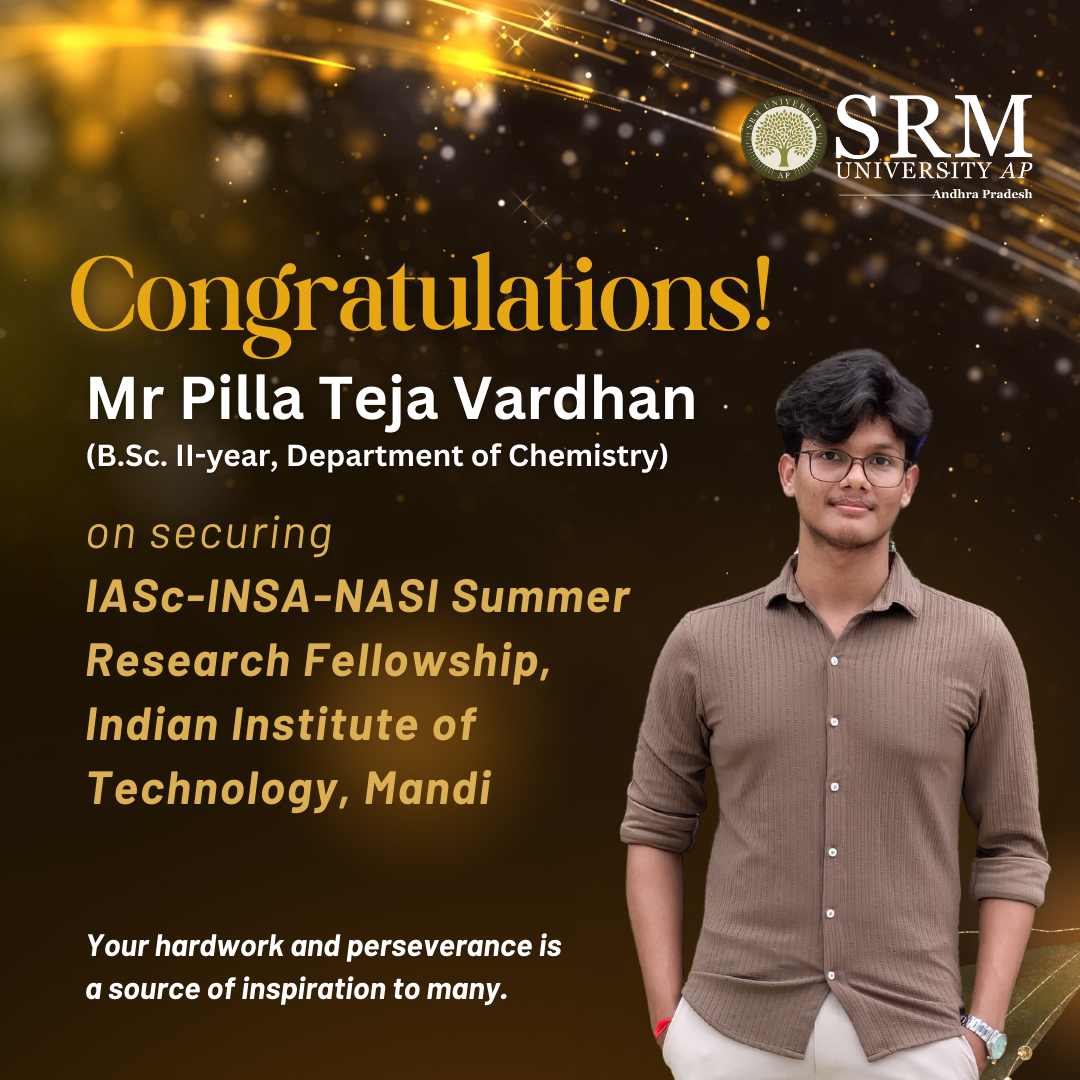 Mr Pilla Teja Vardhan, a second-year B.Sc. Chemistry student, has been selected for the highly prestigious IASc-INSA-NASI Summer Research Fellowship 2025. This esteemed fellowship is jointly offered by the Indian Academy of Sciences (IASc), Indian National Science Academy (INSA), and The National Academy of Sciences, India (NASI) India’s premier scientific institutions committed to nurturing research talent across the country.
Mr Pilla Teja Vardhan, a second-year B.Sc. Chemistry student, has been selected for the highly prestigious IASc-INSA-NASI Summer Research Fellowship 2025. This esteemed fellowship is jointly offered by the Indian Academy of Sciences (IASc), Indian National Science Academy (INSA), and The National Academy of Sciences, India (NASI) India’s premier scientific institutions committed to nurturing research talent across the country.
As part of this elite program, Teja Vardhan will spend eight weeks at the Indian Institute of Technology (IIT), Mandi, under the expert mentorship of Dr Amit Jaiswal, engaging in cutting-edge research in the field of Nanomatter and advanced material chemistry. This opportunity will enable him to gain valuable hands-on research experience, deepen his scientific insight, and contribute to ongoing investigations in frontier areas of science.
The IASc-INSA-NASI Summer Research Fellowship is known for its rigorous selection process and generous support. Selected students receive a monthly stipend of ₹12,500. The fellowship ensures a fully supported and immersive research experience at some of India’s leading scientific institutions.
About the Fellowship
The IASc-INSA-NASI Summer Research Fellowship Program is one of India’s most competitive undergraduate research initiatives, designed to provide meritorious students with exposure to advanced scientific research. Fellows work closely with leading researchers across academic and national laboratories, fostering a strong foundation for future scientific careers.
- Published in Chemistry-news, Departmental News, News, Research News, Students Achievements
Folded Aromatic Polyamides Enabling Faster Charge Transport
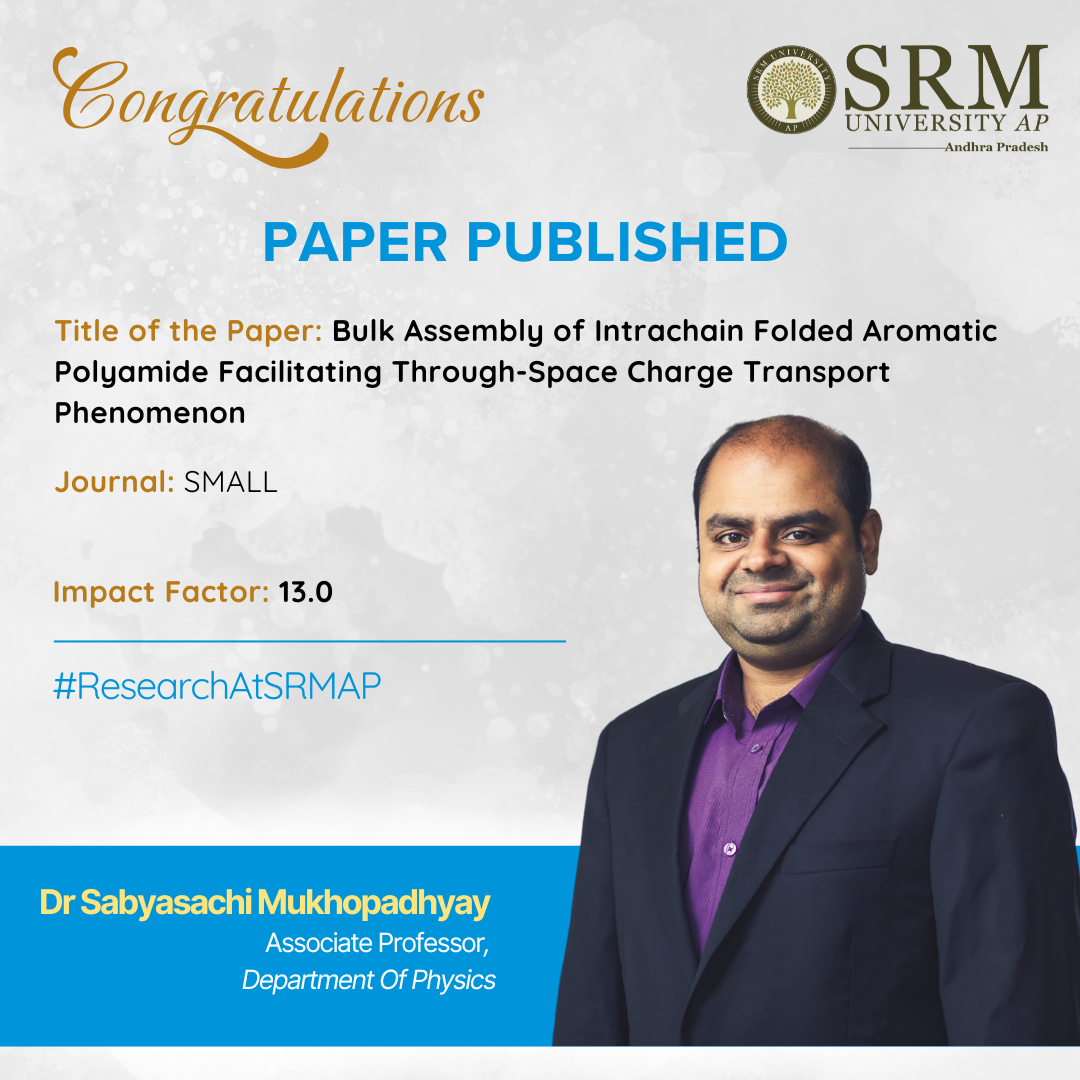 In the quest for next-generation organic electronic materials, researchers have drawn inspiration from nature’s intricate designs. A groundbreaking study titled “Bulk Assembly of Intrachain Folded Aromatic Polyamides Facilitating Through-Space Charge Transport Phenomenon” led by Dr Sabyasachi Mukhopadhyay, Associate Professor in the Department of Physics, introduces a novel class of polymers that mimic the secondary structures of biomolecules. Published in the high-impact Q1 journal SMALL with an Impact Factor of 13.0, this research unveils the potential of intrachain folded aromatic polyamides in facilitating efficient through-space charge transport.
In the quest for next-generation organic electronic materials, researchers have drawn inspiration from nature’s intricate designs. A groundbreaking study titled “Bulk Assembly of Intrachain Folded Aromatic Polyamides Facilitating Through-Space Charge Transport Phenomenon” led by Dr Sabyasachi Mukhopadhyay, Associate Professor in the Department of Physics, introduces a novel class of polymers that mimic the secondary structures of biomolecules. Published in the high-impact Q1 journal SMALL with an Impact Factor of 13.0, this research unveils the potential of intrachain folded aromatic polyamides in facilitating efficient through-space charge transport.
Abstract :
This study presents the design and synthesis of periodically grafted aromatic Polyamides capable of intrachain folding, mimicking secondary structures seen in biomolecules. Leveraging the immiscibility between aromatic backbones and Polyethylene glycol (PEG) side chains, the polymers self-assemble into lamellar, phase-separated domains with ordered π-stacking.
The structural order is further enhanced by incorporating aromatic guest molecules, enabling efficient through-space charge transport. Structural and morphological investigations via SAXS, WAXS, AFM, and TEM confirm the formation of highly ordered π-domains. Charge transport measurements reveal vertical current densities as high as 10⁻⁴ A/cm² in annealed host–guest complexes, comparable to conventional conjugated polymers, demonstrating the potential of these materials for stable, anisotropic organic electronics.
Practical implementation :
This research provides a new strategy for designing flexible, stable, and efficient organic electronic materials without the need for traditional conjugated polymers. The ability to precisely control the orientation and spacing of conductive regions at
The nanoscale opens doors for:
- Wearable and stretchable electronics
- Flexible sensors and low-power devices
- Organic transistors and memory devices with tunable directionality
- Environmentally stable devices, useful in humid or high-temperature conditions
- These innovations can lower manufacturing costs, enhance sustainability, and enable novel applications in healthcare, IoT, and smart textiles.
This research was a collaborative effort between multiple departments and institutions including Department of Chemical Sciences, IISER Mohali, Department of Physical Sciences, IISER Mohali and Department of Physics, SRM University – AP (Ramkumar K, Dr Sabyasachi Mukhopadhyay) and was supported by Department of Science and Technology – Science and Engineering Research Board (DST-SERB)
Future research plans:
Dr Sabyasachi Mukhopadhyay is working towards “Integrated Center for Organic Electronics” – a multidisciplinary innovation hub focused on designing the next generation of flexible, sustainable, and high-performance electronic materials and devices.
- Published in Departmental News, News, Physics News, Research News
The ‘Unholy’ Trinity: Repression of the Working- Class in Late-Colonial Bengal
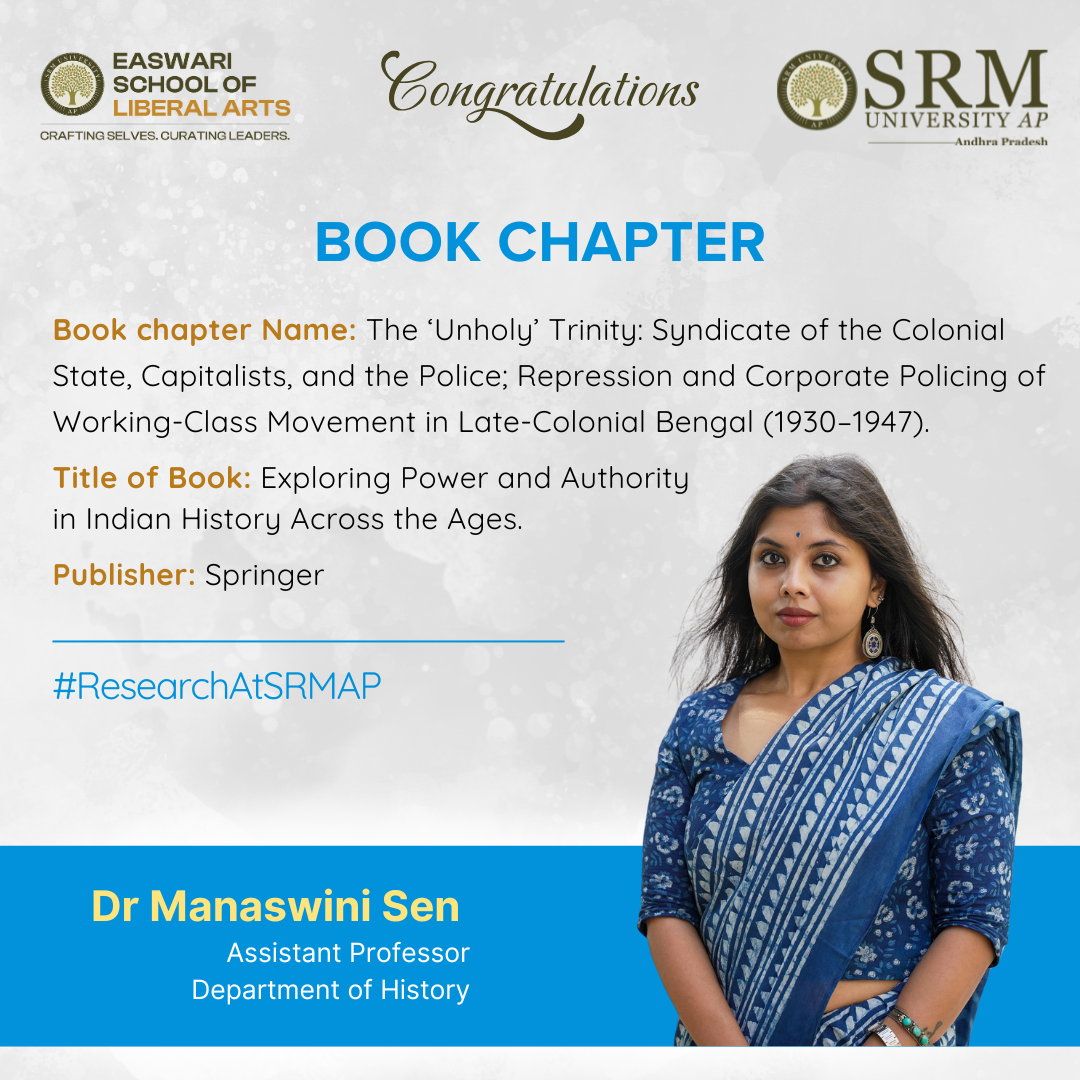 Dr Manaswini Sen, Assistant Professor in the Department of History at SRM University – AP, Amaravati in her chapter titled “The ‘Unholy’ Trinity: Syndicate of the Colonial State, Capitalists, and the Police; Repression and Corporate Policing of Working-Class Movement in Late-Colonial Bengal (1930–1947)”, published in Exploring Power and Authority in Indian History Across the Ages (Springer), investigates how the colonial state, capitalist interests, and the police referred to as the “unholy trinity”collaborated to repress working-class movements in late-colonial Calcutta between 1930 and 1947.
Dr Manaswini Sen, Assistant Professor in the Department of History at SRM University – AP, Amaravati in her chapter titled “The ‘Unholy’ Trinity: Syndicate of the Colonial State, Capitalists, and the Police; Repression and Corporate Policing of Working-Class Movement in Late-Colonial Bengal (1930–1947)”, published in Exploring Power and Authority in Indian History Across the Ages (Springer), investigates how the colonial state, capitalist interests, and the police referred to as the “unholy trinity”collaborated to repress working-class movements in late-colonial Calcutta between 1930 and 1947.
The study examines the complex interests of the capitalist class and the British imperial state in late colonial India, focusing on their collective oppression towards labor radicalisation. It examines the legal measures taken by the British imperial state to monitor working-class militarisation and the strategies employed by capitalists to disrupt strikes and deny workers’ claims.
The chapter also discusses the establishment of white or pro-state unions that used communalism to disrupt strikes and hinder revolutionary union movements in late colonial Calcutta. The chapter provides new perspectives on competition-collaboration theories, discusses the role of Indian capitalists, and explores the question of communalism in trade union politics in late colonial Bengal. It is relevant for those working in labour history, mass movement history, late colonial Calcutta, and urban history.
About the book :
Exploring Power and Authority in Indian History Across the Ages offers a nuanced exploration of power and authority in Indian history through a series of case studies spanning different regions and time periods. It examines the sociological, cultural, economic, and historical dimensions of power, critiques dominant ideologies, and highlights responses from marginalised groups. Providing insights into diverse political structures from ancient to modern times, this volume is a valuable resource for historians, scholars, and researchers of Indian and South Asian history.
- Published in Departmental News, History Current Happenings, History News, News, Research News
SRM-AP Partners with Elevium to Offer Industry-Aligned Courses
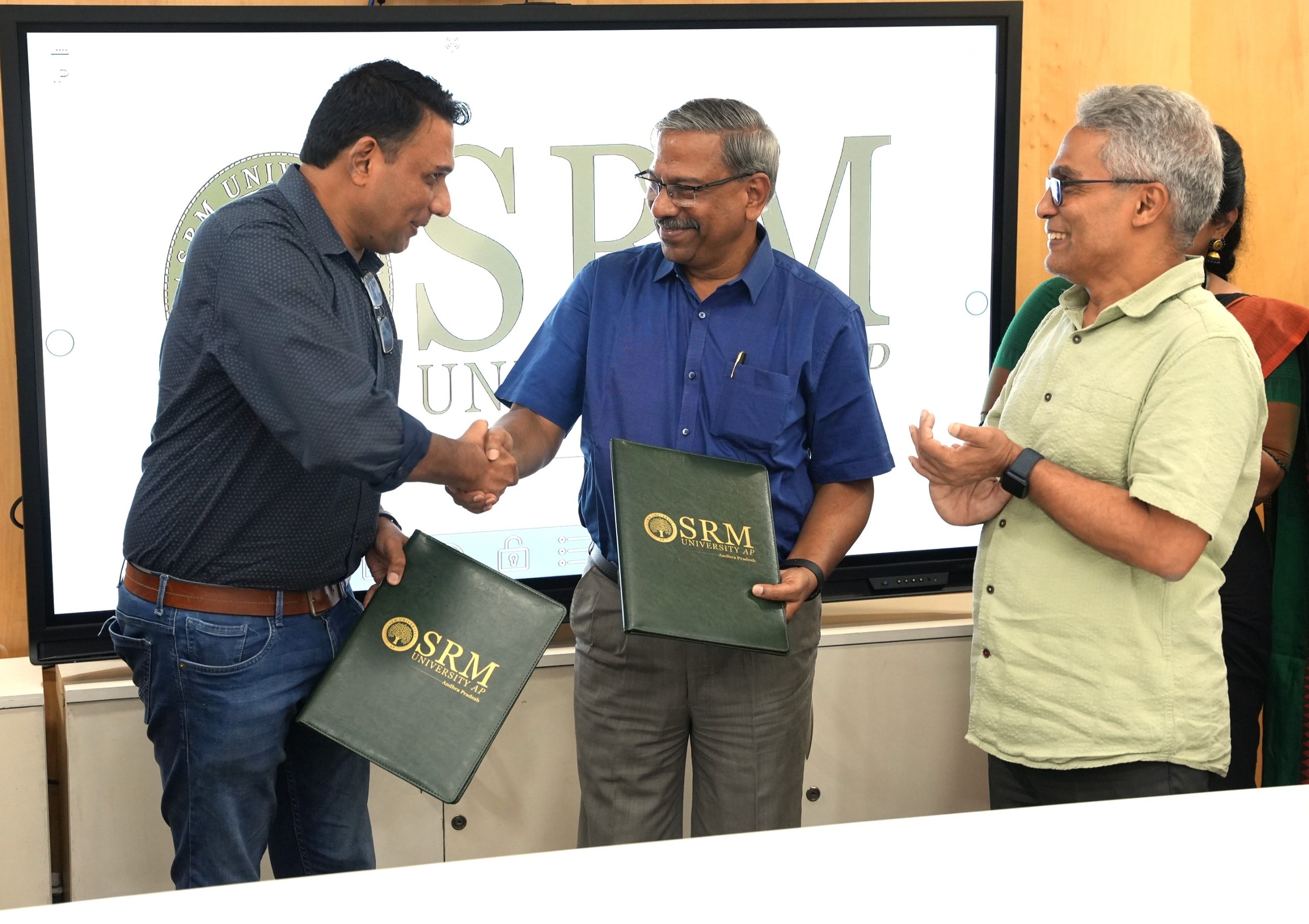 In a significant move to enhance skill-based learning through academia–industry collaboration, SRM University-AP, Amaravati, has entered into a strategic Memorandum of Agreement (MoA) with Elevium a division of Nanochip Skills Pvt. Ltd, a leading Bengaluru-based industry partner, to deliver cutting-edge, industry-aligned courses to students of the Department of Electronics and Communication Engineering (ECE).
In a significant move to enhance skill-based learning through academia–industry collaboration, SRM University-AP, Amaravati, has entered into a strategic Memorandum of Agreement (MoA) with Elevium a division of Nanochip Skills Pvt. Ltd, a leading Bengaluru-based industry partner, to deliver cutting-edge, industry-aligned courses to students of the Department of Electronics and Communication Engineering (ECE).
This partnership bridges the gap between theoretical education and real-world industry requirements, particularly for ECE students. As part of the MoA, undergraduate ECE students from the 3rd to 7th semesters will have the opportunity to enroll in specialised, industry-aligned courses in VLSI, Embedded Systems, and Edge AI key domains shaping the future of the electronics sector.
Key Highlights of the Agreement:
Structured Course Delivery: One industry-aligned course per semester, each comprising 60 hours – delivered through a hybrid model of 40% offline and 60% online learning.
Enrollment Strategy: Designed for a minimum batch size of 120 students, with optional enrollment extended to students from other departments based on institutional discretion.
Elevium will provide expert faculty from the industry, handle curriculum delivery, conduct assessments, and participate in curriculum review through Board of Studies meetings. SRM University-AP will facilitate access to classrooms, labs, and administrative support to integrate these courses seamlessly into the academic structure.
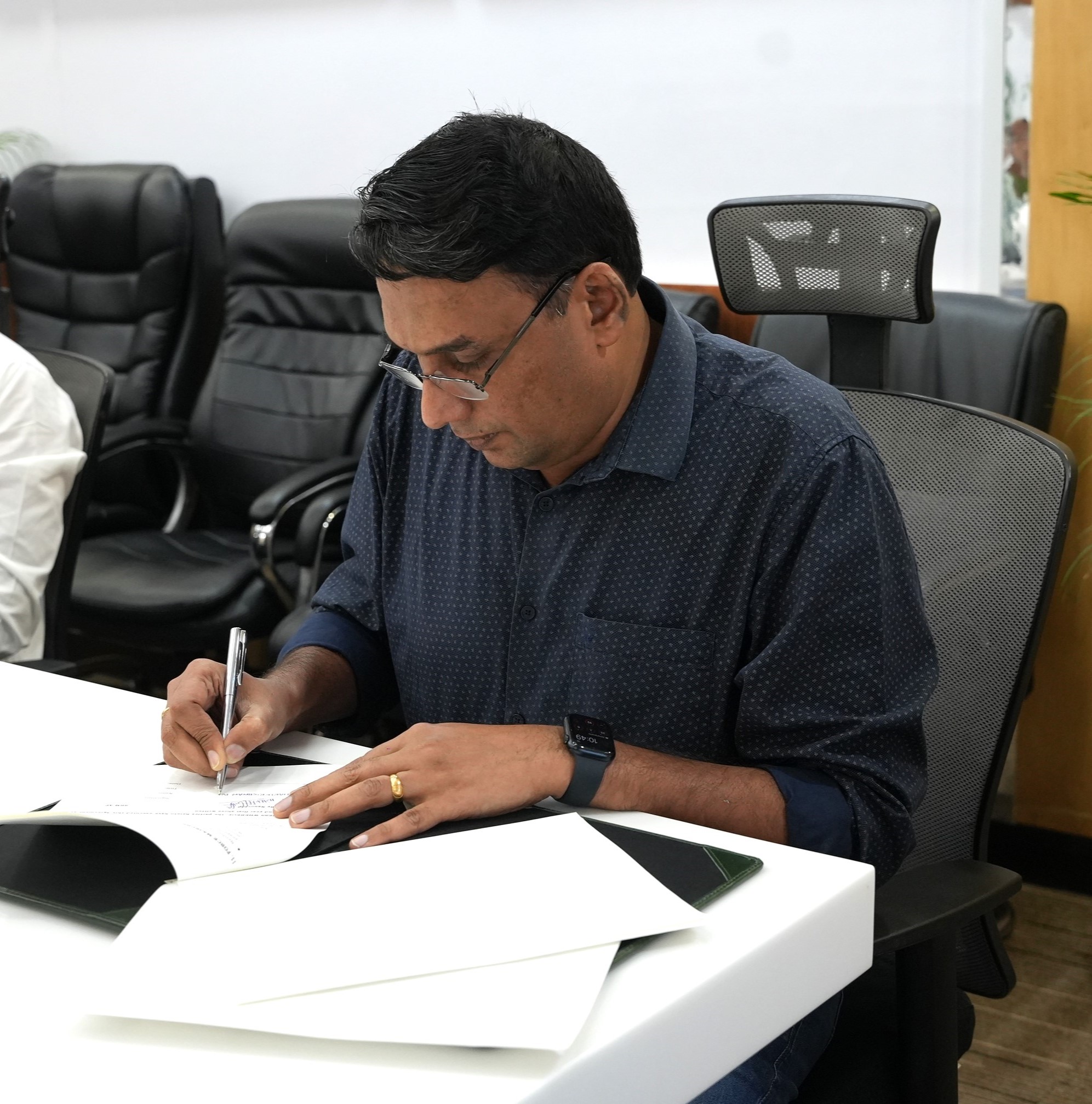
Student Evaluation and Curriculum Design:
Assessment methods and syllabus structures will be collaboratively developed and aligned with SRM-AP’s academic standards. The courses will include continuous evaluations and feedback mechanisms, with grading support from Elevium.
Placement and Career Support:
As part of its commitment, Elevium will extend comprehensive placement support including career counseling, guest lectures by industry experts, internship facilitation, and project guidance to enhance students’ employability.
The primary goal of the MoA is to empower undergraduate students with hands-on learning aligned with current industrial practices and to facilitate their transition from classroom to the corporate world through structured and practice-driven academic modules.
The agreement was formally signed in the presence of esteemed dignitaries from both organisations, including Hari Krishnan Puravankara, CEO of Nanochip Group of Companies, Dr Manoranjan Kumar, Manager of university Programs at Nanochip Group of Companies, Dr Prem Kumar, Registrar, Prof. C V Tommy, Dean of SEAS, and other faculty members from the ECE department.
This collaboration exemplifies SRM-AP’s commitment to transforming education by integrating academic knowledge with industrial applications. Thus, students are empowered with real-world competencies that are crucial for tomorrow’s technology leaders.
- Published in Departmental News, ECE NEWS, MoU, News
Advancing Next-Gen PEM Fuel Cells: Role of Nanostructured Catalysts
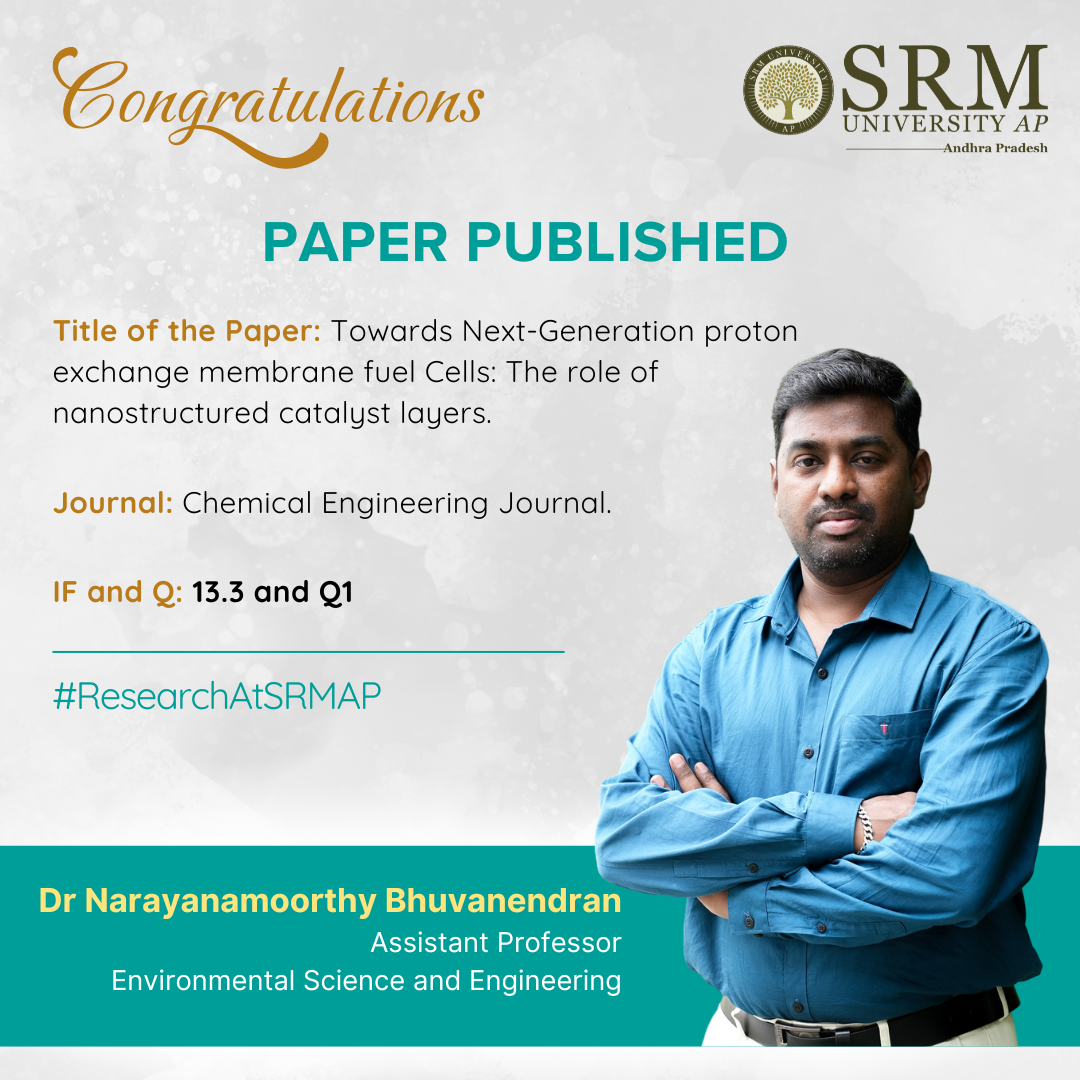 The transition to sustainable energy sources has become imperative due to the exhaustion of conventional resources caused by excessive use and their detrimental impact on the environment. Currently, alternative energy sources, such as solar, wind, nuclear, tidal, and geothermal energy, hydro have been introduced. Over the last few decades, focus has shifted to the use of hydrogen energy as a promising alternative to traditional power sources in almost all sectors requiring energy applications.
The transition to sustainable energy sources has become imperative due to the exhaustion of conventional resources caused by excessive use and their detrimental impact on the environment. Currently, alternative energy sources, such as solar, wind, nuclear, tidal, and geothermal energy, hydro have been introduced. Over the last few decades, focus has shifted to the use of hydrogen energy as a promising alternative to traditional power sources in almost all sectors requiring energy applications.
However, a major challenge holding back their widespread use is the high cost and limited performance of a key component called the catalyst layer (CL). This layer is responsible for speeding up the chemical reaction that generates electricity, but it typically requires a large amount of platinum, a rare and expensive metal and often has a thick, disordered structure that reduces efficiency.
This research, titled “Towards Next-Generation proton exchange membrane fuel Cells: The role of nanostructured catalyst layers” led by Dr. Narayanamoorthy Bhuvanendran, Assistant Professor, Department of Environmental Science and Engineering, was published in the Q1 Journal, Chemical Engineering Journal, with an Impact Factor of 13.4. The paper focuses on designing advanced nanostructured catalyst layers that are thinner, more organised, and use much less platinum. These next-generation CLs can help fuel cells perform better, last longer, and become more affordable.
The study reviews recent progress in this field, highlights innovative methods for creating these new structures, and outlines future directions to improve their practicality and environmental impact. Ultimately, this work aims to bring us closer to clean, efficient, and widely accessible fuel cell technology.
Fuel cells offer clean energy with zero emissions when using hydrogen, and higher energy efficiency than diesel or gas engines. Among them, Proton Exchange Membrane Fuel Cells (PEMFCs) are one of the most promising technologies. PEMFCs produce only water as a byproduct, making them a clean energy alternative to fossil fuels.
Abstract:
Catalyst layer (CL) is the major component of proton exchange membrane fuel cells (PEMFCs) and routinely fabricated by a catalyst ink-based processing method. Such conventional CLs typically confront low activity, unaffordable Pt loading, and severe mass transport issues due to the thick and disordered structure, hampering the widespread commercial application of PEMFCs.
Engineering of nanostructured CLs with low/ultralow Pt loading, ordered and/or ultrathin CLs, provides a highly promising pathway for overcoming these limitations. For the practical application of the nanostructured CLs in PEMFCs, this review comprehensively summarises and comments on the important research and development of nanostructured CLs over recent years, involving ordered electronic conductor-based CLs, ordered ionomer-based CLs, and ultrathin CLs.
The reviewed processes include
(i) analysing the motivation and necessity to design and fabricate nanostructured CLs based on the structure and mass transport process of conventional CLs,
(ii) scrutinising structure and composition, preparation methods, advantages, as well as
some feasible strategies for the remaining challenges of various nanostructured CLs in
detail,
(iii) the progress of single cell activity and durability of the nanostructured CLs. Finally, some perspectives on remaining challenges and future development of the nanostructured CLs are presented to guide the exploitation for the next-generation of advanced CLs of PEMFCs.
Practical implementations:
The practical objective of this study is to facilitate the development of more efficient, cost-effective, and durable proton exchange membrane fuel cells (PEMFCs) through the redesign of the catalyst layer utilising advanced nanostructures. This enhancement has the potential to substantially decrease dependence on costly platinum, reduce production expenses, and enhance the overall performance of fuel cells.
In terms of societal impact, this research contributes to the transition towards clean and sustainable energy systems, thereby reducing greenhouse gas emissions and air pollution associated with conventional fossil fuels. By making fuel cell technology more accessible and scalable, particularly for transportation and portable power applications, it supports global initiatives to combat climate change and improve energy security for future generations.
Collaborations:
Prof. Huaneng Su, Institute for Energy Research, Jiangsu University, Zhenjiang, China.
- Published in Departmental News, ENVS News, News, Research News
Critical agendas for the areal linguistics: locating Sindhi within South Asia
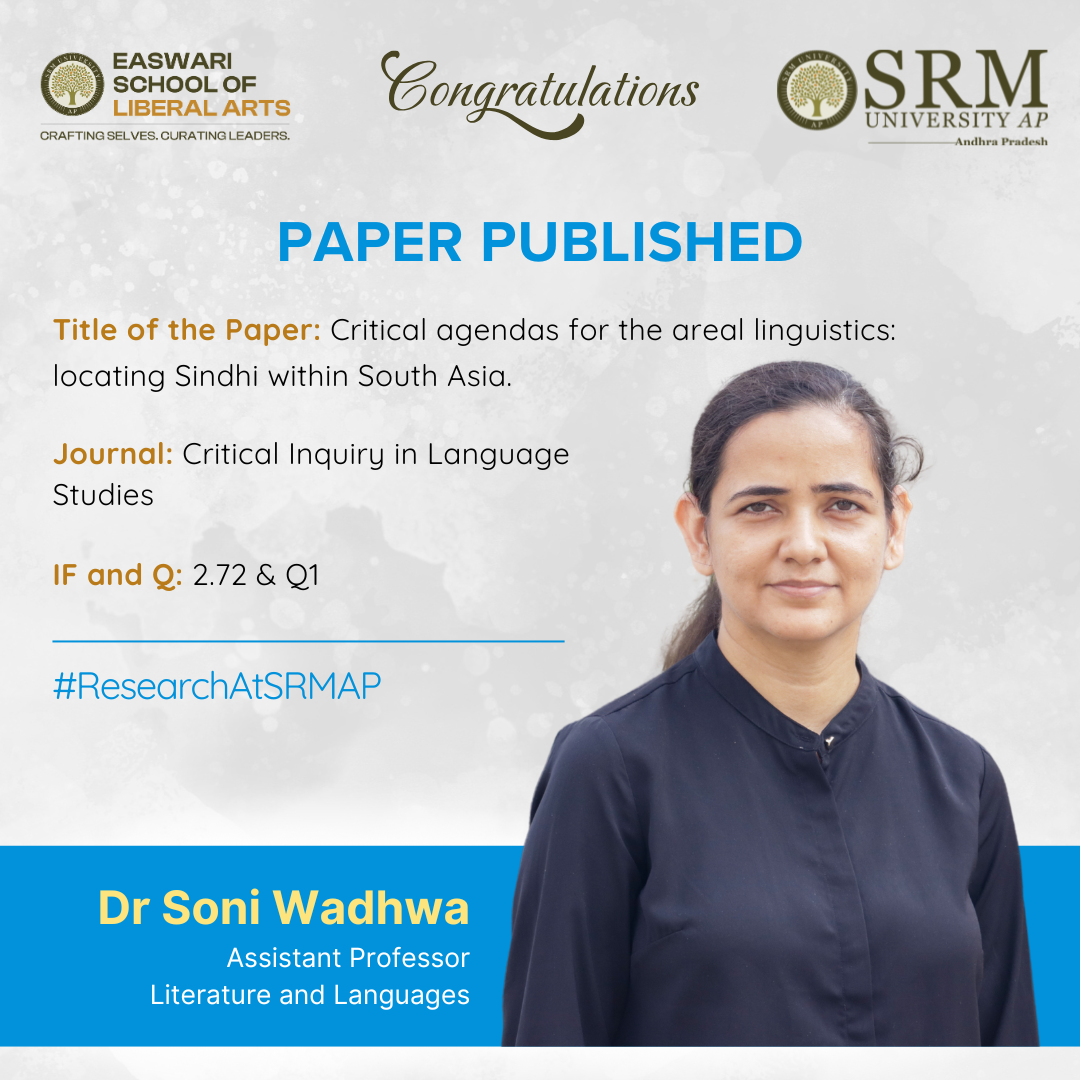 The Sindhi language presents a compelling case for examining the intersections of language, territory, and identity in the post-Partition context. In India, Sindhi often survives as a spoken language, primarily confined to the domestic sphere. This restricted use raises important questions about the conditions necessary for linguistic vitality.
The Sindhi language presents a compelling case for examining the intersections of language, territory, and identity in the post-Partition context. In India, Sindhi often survives as a spoken language, primarily confined to the domestic sphere. This restricted use raises important questions about the conditions necessary for linguistic vitality.
Exploring the complexities surrounding Sindhi Dr Soni Wadhwa, Assistant Professor in the Department of Literature and Languages, has published a research article titled “Critical agendas for the areal linguistics: locating Sindhi within South Asia” in the Q1 journal Journal of Critical Inquiry in Language Studies. This publication contributes significantly to scholarly discussions on areal linguistics, offering critical insights into the precarious position of Sindhi and the broader implications for language studies in postcolonial South Asia.
This article explores these dynamics to foreground the often-overlooked role of technological, epistemological, and aesthetic resources in sustaining minority languages. In doing so, it positions Sindhi as a critical lens through which to understand the challenges faced by minoritised languages in the Global South, particularly those without a clear territorial anchoring.
Abstract
As a concept within applied linguistics, areal linguistics concerns itself with investigating the nature of structural similarities among languages produced by contact rather than by history or by genetic similarities. A critical look at its descriptive linguistic agendas reveals that the domain needs to be revisited in terms of questions of power relations and linguistic inequalities within specific linguistic
areas. Such investigations reconfigure the dynamics of geography and regionality within language as a site of power.
This study seeks to make an intervention into India as a linguistic area with a focus on Sindhi, a non-regional language in India. Given that the language and the community do not have a state or a linguistic territory within India, the condition of Sindhi is characterised by a sense of precarity. Seen through the prism of India as a linguistic area, this precarity is not quite visible. In revisiting the celebrated concept of India as a linguistic area, this study suggests ways of asking contemporary questions about areal linguistics that go beyond describing the nature of contact among languages, and instead ask how this contact impacts the markers of hegemony over minor languages in terms of technological,epistemological, and aesthetic leverage.
Social Implications of the Research
This research might help in building further study around minority languages in India as well as elsewhere in the Global South, we empower more languages. This will help people who know regional languages access the Internet and other aspects that Digital India aspires to address.
Sindhis in India are scattered in different cities and speak the regional or state languages or English at home. This work helps in pushing more research on the language and the community which can further inform policies for linguistic empowerment.
- Published in Departmental News, English Current Happenings, News, Research News
Special Lecture on Future of Migration in India
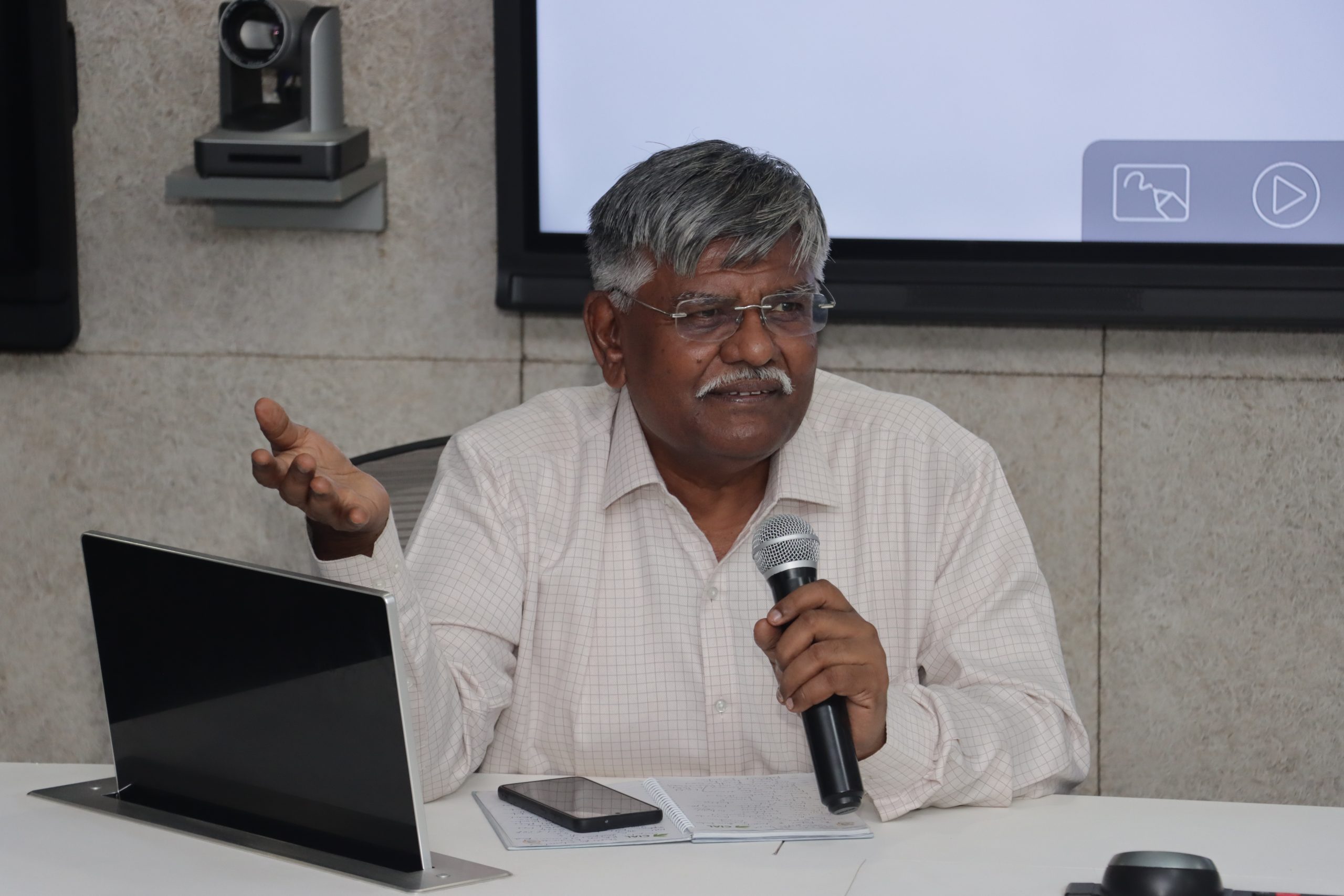
The Department of Economics, Easwari School of Liberal Arts, organised a lecture on the topic “Future of Migration in India”. Prof. S Irudaya Rajan, Distinguished Visiting Faculty at the Department and Chairman of the International Institute of Migration and Development (IIMAD), Kerala, delivered an engaging talk for the special lecture.
Prof. Rajan, a leading demographer and renowned expert in migration studies, provided an in-depth analysis of India’s internal and international migration trends. He discussed the implications of demographic changes, urbanisation, labour market dynamics, and policy challenges. Drawing from empirical data and his extensive research, he stressed the urgent need for a comprehensive migration policy in India, particularly in light of reverse migration during COVID-19 and the growing issue of climate-induced displacement. He also touched upon the demographic consequences of migration, including its impact on fertility and mortality rates.
The talk attracted participants from diverse academic backgrounds, including faculty members, undergraduate students, and research scholars. The lecture concluded with a lively Q&A session, reflecting a strong interest in migration and development issues among attendees.
The event was a resounding success, contributing meaningfully to academic dialogue at SRM University-AP. It reinforced the institution’s commitment to interdisciplinary research and public policy engagement, while offering valuable insights into one of India’s most pressing socio-economic challenges.
- Published in Departmental News, Economics Current Happenings, News

